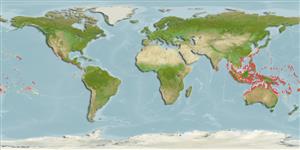Common names from other countries
分類 / Names
俗名 | 同種異名 | Catalog of Fishes(屬, 種) | ITIS | CoL | WoRMS | Cloffa
Teleostei >
Blenniiformes (Blennies)
鱸形目 (Blennies) >
Blenniidae (Combtooth blennies)
鳚科 (Combtooth blennies) > Blenniinae
Etymology: Aspidontus: Greek, aspis, -idos = shield + Latin, dens, dentis = teeth (Ref. 45335).
More on authors: Quoy & Gaimard.
Environment: milieu / climate zone / depth range / distribution range
生態學
海洋 礁區魚類; 深度上下限 1 - 25 m (Ref. 90102). 熱帶; 32°N - 32°S
Indo-Pacific.
太平洋: 在東印度洋到列島群島,馬貴斯群島與 Tuamoto 島中的可可群島-基靈群島 (參考文獻 9399) 與聖誕島 (參考文獻 30874), 北至日本南部, 南至新南威爾斯; 在密克羅尼西亞各處。
大小 / 重量 / 年齡
Maturity: Lm ? range ? - ? cm
Max length : 11.5 cm TL 雄魚/尚未辨別雌雄; (Ref. 9710)
背棘 (總數) : 10 - 12; 背的軟條 (總數) : 26 - 28; 臀棘: 2; 臀鰭軟條: 25 - 28. Bears an amazing resemblance to the cleaner wrasse, Labroides dimidiatus. Distinguished from L. dimidiatus by the position of its mouth, which is terminal in the wrasse but under the snout in the blenny.
有一個令人驚異的樣似清潔工隆頭魚, 裂唇魚〔Labroides dimidiatus〕 。 與 L. dimidiatus 區分了藉由它的嘴的位置, 在隆頭魚中是終點但是在吻部下面在黏魚中。
Adults are found solitary or in small groups (Ref. 90102) in lagoons, subtidal reef flats and outer reef slopes (where it occurs to depths of over 20 m). Often in pairs in empty worm tubes or narrow holes. They mimic the cleaner wrasse Labroides dimidiatus and nip fins, skin and scales of other fishes (Ref. 9710). They even copy the motion of the cleaner wrasse that may induce other fish to come close, then target their scales or mucus for a feed, biting and quickly retreating to the corals before the victim realizes that it was tricked; experienced fish recognize imposters and often give it a chase (Ref. 48636). Diet is supplemented with benthic invertebrates and zooplankton (Ref. 94105). Also feed on tubeworms and demersal fish eggs. Oviparous. Eggs are demersal and adhesive (Ref. 205), and are attached to the substrate via a filamentous, adhesive pad or pedestal (Ref. 94114). Larvae are planktonic, often found in shallow, coastal waters (Ref. 94114).
棲息於潟湖,亞潮間帶的礁石平臺與外礁斜坡。 (在那裡它出現到深度超過 20 公尺) 常見於在空的蠕蟲管或狹窄的洞中生活在對中。 擬態清潔工隆頭魚 裂唇魚〔Labroides dimidiatus〕 而且捏鰭,皮膚與其他魚的魚鱗。 (參考文獻 9710) 它甚至抄襲可能引誘其他的魚來結束的清潔工隆頭魚的運動,但是它對於一個吃鎖定他們的鱗片或者黏液, 咬而且很快地撤退到珊瑚在受害者了解它被戲弄之前; 富有經驗的魚認識冒充者而且時常給它一個追逐。 (參考文獻 48636) 也吃管蟲與底棲魚卵。 卵生的.(參考文獻 205)
Life cycle and mating behavior
Maturities | 繁殖 | Spawnings | Egg(s) | Fecundities | 仔魚
Distinct pairing (Ref. 205).太平洋: 在東印度洋到列島群島,馬貴斯群島與 Tuamoto 島中的可可群島-基靈群島 (參考文獻 9399) 與聖誕島 (參考文獻 30874), 北至日本南部, 南至新南威爾斯; 在密克羅尼西亞各處。
Smith-Vaniz, W.F., B.C. Victor and G.R. Allen, 2020. Aggressive mimicry in Aspidontus and Plagiotremus (Pisces: Blenniidae): some mimetic phenotypes are not phylogenetically informative. J. Ocean Sci. Found. 35:118-128. (Ref. 123078)
CITES (Ref. 128078)
Not Evaluated
人類使用
漁業: 商業性; 水族館: 商業性
工具
特別的報告
下載 XML
網路資源
Estimates based on models
Preferred temperature (Ref.
115969): 25.1 - 29.3, mean 28.5 (based on 2575 cells).
Phylogenetic diversity index (Ref.
82804): PD
50 = 0.6250 [Uniqueness, from 0.5 = low to 2.0 = high].
Bayesian length-weight: a=0.00562 (0.00258 - 0.01228), b=3.06 (2.87 - 3.25), in cm Total Length, based on LWR estimates for this (Sub)family-body shape (Ref.
93245).
營養階層 (Ref.
69278): 3.8 ±0.51 se; based on food items.
回復力 (Ref.
120179): 高度, 族群倍增時間少於 15個月 (Preliminary K or Fecundity.).
Fishing Vulnerability (Ref.
59153): Low vulnerability (10 of 100).
